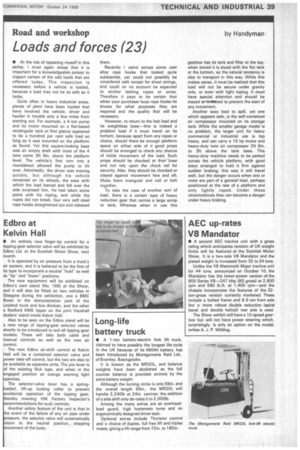Road and workshop
Page 43

If you've noticed an error in this article please click here to report it so we can fix it.
Loads and forces (23)
• At the risk of repeating myself in this series, I must again stress that it is important for a knowledgeable person to inspect certain of the odd loads that are offered today. This inspection is necessary before a vehicle is loaded, because a load may not be as safe as it looks.
Quite often in heavy industrial areas, pieces of plant have been loaded that have involved the vehicle, driver and haulier in trouble only a few miles from starting out. For example, a 4-ton pump and its motor mounted on a flat-based rectangular tank at first glance appeared to be a hundred per cent safe load so long as it was mounted on the platform as found. Yet this square-looking base was an empty shell with most of the 4 tons some 3ft 6in. above the platform level. The vehicle's first turn into a roundabout allowed the pump to tilt over. Admittedly, the driver was moving quickly, but although his vehicle remained on its wheels, the ease with which the load leaned and fell over the side surprised him. He had taken some pains with his roping, and while the ropes did not break, four very soft steel rope hooks straightened out and released them.
Recently I came across some cast alloy rope hooks that looked quite substantial, yet could not possibly be considered safe except for sheet strings, and could on no account be expected to anchor lashing ropes or wires. Therefore it pays to be certain that when your purchaser buys rope hooks he knows for what purposes they are required and the quality that will be necessary.
However, to return to the lost load and its weightless base—this is indeed a problem load if it must travel on its bottom, because apart from any ropes or chains, should there be enough platform space on either side of it good props should be arranged to check any chance of initial movement of the load. Such props should be chocked at their base and not rely upon the chock rail for security. Also, they should be checked or stayed against movement fore and aft. Make them triangular and nail or bolt together.
To take the case of another sort of load, there is a certain type of heavy reduction gear that carries a large sump or tank. Whereas when in use this
gearbox has its tank and filter at the top, when stored it is stood with the flat tank at the bottom, so the natural tendency is also to transport in this way. While this makes sense, it must be realized that this load will not be secure under gravity only, or even with light roping. It must have special attention and should be stayed or-timbered to prevent the start of any movement.
Another easy load to spill, yet one which appears safe, is the self-contained air compressor mounted on its storage tank. While the smaller garage model is no problem, the larger unit for heavy commercial or industrial use is top heavy, and can carry a 10 hp motor and heavy-duty twin air compressor 2ft 6in, to 3ft above the tank base. This heavy-duty machine needs to be parked across the vehicle platform, with good stays arranged to hold it firm against sudden braking; this way it will travel well, but the danger occurs when one or more are part of a general load, perhaps positioned at the rear of a platform and only lightly roped. Under these circumstances they can become a danger under heavy braking.




















































































































